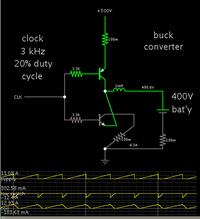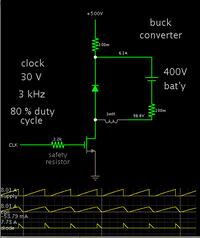newbie28
Newbie level 4
Hi. I am trying to design a bidirectional DC/DC converter. It has a DC bus on HV side and a battery on the LV side. The DC bus is rated at 500V and battery at 400V, 50Ah.
 . The battery internal resistance is pretty low. How do I limit the output current of the converter to suit the battery rating? As I know the output current is (Vout/Rload). But here Rload is very small and hence the current is very large. (Please correct me if my understanding is wrong). I tried putting a 2.5microF capacitor across the battery, but still I am getting current of the order of 700A in SIMULINK. (for now, I am using a resistor as load). I tried using battery in SImPowerSystems. Got scared by the output I saw and hence decided to try with a resistor first. I really need to finish this today. Been struggling with this since 3 weeks. Plz help me! Thank you!
. The battery internal resistance is pretty low. How do I limit the output current of the converter to suit the battery rating? As I know the output current is (Vout/Rload). But here Rload is very small and hence the current is very large. (Please correct me if my understanding is wrong). I tried putting a 2.5microF capacitor across the battery, but still I am getting current of the order of 700A in SIMULINK. (for now, I am using a resistor as load). I tried using battery in SImPowerSystems. Got scared by the output I saw and hence decided to try with a resistor first. I really need to finish this today. Been struggling with this since 3 weeks. Plz help me! Thank you!
 . The battery internal resistance is pretty low. How do I limit the output current of the converter to suit the battery rating? As I know the output current is (Vout/Rload). But here Rload is very small and hence the current is very large. (Please correct me if my understanding is wrong). I tried putting a 2.5microF capacitor across the battery, but still I am getting current of the order of 700A in SIMULINK. (for now, I am using a resistor as load). I tried using battery in SImPowerSystems. Got scared by the output I saw and hence decided to try with a resistor first. I really need to finish this today. Been struggling with this since 3 weeks. Plz help me! Thank you!
. The battery internal resistance is pretty low. How do I limit the output current of the converter to suit the battery rating? As I know the output current is (Vout/Rload). But here Rload is very small and hence the current is very large. (Please correct me if my understanding is wrong). I tried putting a 2.5microF capacitor across the battery, but still I am getting current of the order of 700A in SIMULINK. (for now, I am using a resistor as load). I tried using battery in SImPowerSystems. Got scared by the output I saw and hence decided to try with a resistor first. I really need to finish this today. Been struggling with this since 3 weeks. Plz help me! Thank you!

